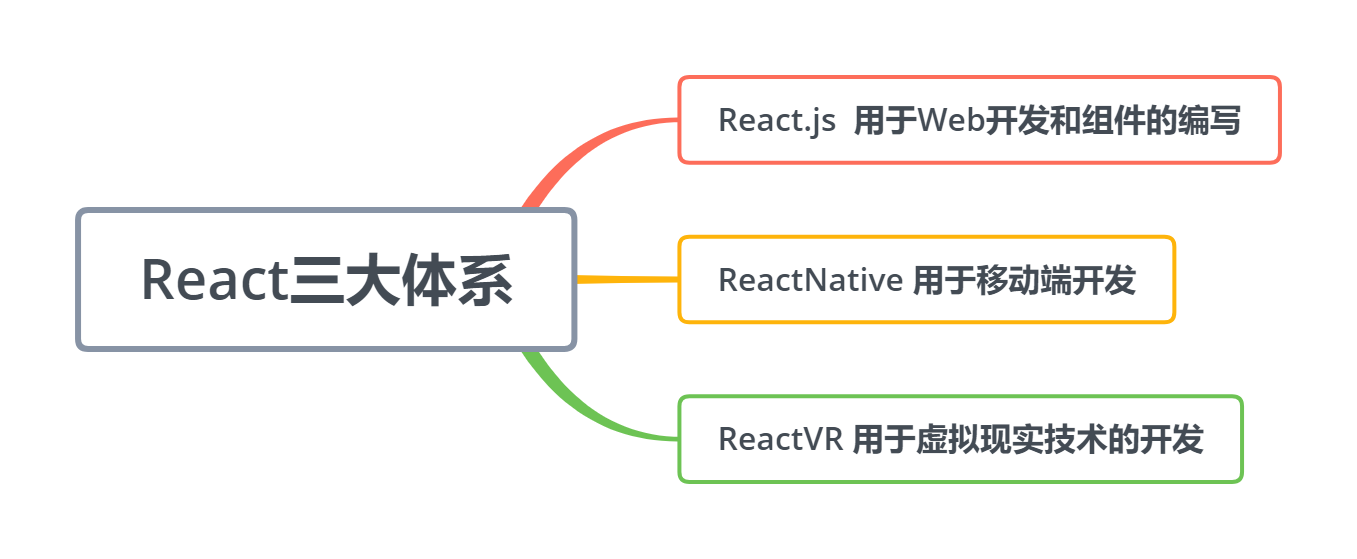应用:
分类:
与vue的对比:
- favicon.ico:项目图标
- index.html:首页模板文件
- mainifest.json:移动端配置文件
- robots.txt:存放于网站根目录下的ASCII编码的文本文件,它通常告诉网络搜索引擎的漫游器(又称网络蜘蛛),此网站中的哪些内容是不应被搜索引擎获取的,哪些是可以被获取的
src:
- index.js:项目的入口文件
- index.css:index.js的样式文件
- app.js:相当于一个方法模块(app.css)
serviceWorker.js: 这个是用于写移动端开发的,PWA必须用到这个文件,有了这个文件,就相当于有了离线浏览的功能。
JSX语法:
JSX=Javascript + XML。React发明了JSX,可以方便的利用HTML语法来创建虚拟DOM,当遇到<,JSX就当作HTML解析,遇到{就当JavaScript解析.
- 自定义的组件必须首写字母要进行大写,而JSX是小写字母开头的
- JSX语法默认情况下最外层只能有一个组件
- 如需要外层有多个组件可以使用Fragment标签,
import React from 'react'const Fragment=React.Fragment<Fragment><header className="App-header">this is react</header><ComponentX name="自定义组件"/></Fragment>
react设计模式:
- constructor,super(),state,setState
方法:
<input value={this.state.name} onChange={this.changeContent.bind(this)}/>
class的方法里面的this指向该对象的实例,如没有则指向指向该方法运行时所在的环境,但是类和模块的内部,默认就是严格模式,this指向undefined,所以需要手动绑定,如果是向子组件传入方法则此时this指向父组件的props对象
- react是单向数据流,不支持数据双向绑定,需要事件驱动
- 箭头函数里函数体用()包裹则自动默认返回函数体的内容,{}包裹则只是普通函数
- 不允许直接改变或直接操作state,后期优化会产生很大的性能障碍
数组的扩展运算符
扩展运算符:把list数组进行了分解,形成了新的数组,然后再进行组合
在用map循环时,需要设置一个不同的key值
addList(){this.setState({list:[...this.state.list,this.state.name]})}
jsx代码采坑:
- 注释:{/ 注释 /}
- css类名:
- html解析:dangerouslySetInnerHTML={{__html:item}}
- label标签和input框绑定,用htmlFor代替for
父子组件传值:
父组件向子组件传递内容,靠属性props的形式传递。
//====================父组件代码=========================<ul>{this.state.list.map((item,index)=>(<li className="red" key={item} onClick={this.delItem.bind(this,index)}>{item}<XiaoItem content={item}/></li>))}</ul>//================子组件=====================import React, { Component } from 'react';class xiaoItem extends Component{render(){return <div>{this.props.content}</div>}}export default xiaoItem
子组件向父组件传递数据
- 子组件时不能操作父组件里的数据的,所以需要借助一个父组件的方法,来修改父组件的内容
- 子组件使用父组件的方法
- 子组件先通过props获取到需要的参数和父组件的方法
- 在子组件中新建一个方法,在这个方法中调用上一步获取到的父组件的方法
//=======================子组件===============import React, { Component } from 'react';class xiaoItem extends Component{handleClick(){this.props.delItem(this.props.idx)}render(){return <div onClick={this.handleClick.bind(this)}>{this.props.content}</div>}}export default xiaoItem//===================父组件=================<ul>{this.state.list.map((item,index)=>(<li className="red" key={item+index} ><XiaoItem content={item} idx={index} delItem={this.delItem.bind(this)}/></li>))}</ul>
单向数据流:
1. 单向数据流
props属性是只读的,不能在子组件中强行改变
如果子组件被调用多次的话,props属性修改会影响所有的被调用的子组件,所以react采用了单向数据流
2. react是否和其他框架结合使用
props校验:
- 导入PropTypes:
import PropTypes from 'prop-types' 配置特定的 propTypes 属性
xiaoItem.propTypes={ content:PropTypes.string, delItem:PropTypes.func, index:PropTypes.number }使用默认的属性值defaultProps:
XiaojiejieItem.defaultProps = { name:'松岛枫' }ref的使用:
作用:加强语义化
addList(){ this.setState({ list:[...this.state.list,this.state.inputValue], inputValue:'' //关键代码--------------start },()=>{ console.log(this.ul.querySelectorAll('div').length) }) //关键代码--------------end }react生命周期:
生命周期函数:指在某一个时刻组件会自动调用执行的函数

Initialization阶段:
Mounting阶段:
伴随着整个虚拟DOM的生成
- componentWillMount:在组件即将被挂载到页面的时刻执行,只在页面刷新时执行一次
- render:组件挂载中,页面state或props发生变化时执行
- componentDidMount:组件挂载完成时被执行,只在页面刷新时执行一次
Updatation阶段:
原因:
- shouldComponentUpdate:在组件更新之前,自动被执行
- componentWillUpdate:在组件更新之前,但shouldComponenUpdate之后被执行。但是如果shouldComponentUpdate返回false,这个函数就不会被执行,后面的内容也都不会执行。
-
小周期二:
componentWillReceiveProps:子组件接收到父组件传递过来的参数,父组件render函数重新被执行,这个生命周期就会被执行。这个组件第一次存在于Dom中,函数是不会被执行的;如果已经存在于Dom中,函数才会被执行
Unmounting阶段:
- componentWillUnmount:组件去除时执行
生命周期函数改善性能:
问题:输入的过程中子组件频繁渲染
解决方法:
shouldComponentUpdate(nextProps,nextState){
//nextProps是变化后的属性,state是变化后的状态
if(nextProps.content!==this.props.content){
return true
}else{
return false
}
}
React中的动画:
与css3结合
class Boss extends Component {
constructor(props) {
super(props);
this.state = {
isShow:false
}
}
callHim(){
var isShow=this.state.isShow
this.setState({
isShow:!isShow
})
}
render() {
return (
<div>
<div className={this.state.isShow?'show':'hide'}>BOSS级角色:孙悟空</div>
<div><button onClick={this.callHim.bind(this)}>点击</button></div>
</div>
);
}
}
//============================样式============
.show{ opacity: 1; transition:all 1.5s ease-in;}
.hide{opacity: 0; transition:all 1.5s ease-in;}
keyframes:
.hide{
animation: hide-item 2s ease-in-out forwards;
}
.show{
animation: show-item 2s ease-in-out forwards;
}
@keyframes hide-item{
0%{
opacity: 1;
color: yellow;
}
50%{
opacity: 0.5;
color: red;
}
100%{
opacity: 0;
color: green;
}
}
@keyframes show-item{
0%{
opacity: 0;
color: green;
}
50%{
opacity: 0.5;
color: red;
}
100%{
opacity: 1;
color: yellow;
}
}
动画库:react-transition-group
三个组件库:
- 引入CSSTransition
import {CSSTransition} from 'react-transition-group' 添加标签
<CSSTransition in={this.state.isShow} timeout={2000} classNames="boss-text"> <div className={this.state.isShow?'show':'hide'}>BOSS级角色:孙悟空</div> </CSSTransition>添加css
- xxx-enter: 进入(入场)前的CSS样式;
- xxx-enter-active:进入动画直到完成时之前的CSS样式;
- xxx-enter-done:进入完成时的CSS样式;
- xxx-exit:退出(出场)前的CSS样式;
- xxx-exit-active:退出动画知道完成时之前的的CSS样式。
- xxx-exit-done:退出完成时的CSS样式。 ```css .input {border:3px solid #ae7000}
.boss-text-enter{ opacity: 0; } .boss-text-enter-active{ opacity: 1; transition: opacity 2000ms;
} .boss-text-enter-done{ opacity: 1; } .boss-text-exit{ opacity: 1; } .boss-text-exit-active{ opacity: 0; transition: opacity 2000ms;
} .boss-text-exit-done{ opacity: 0; } ```
- unmountOnExit属性
在元素退场时,自动把DOM也删除。



